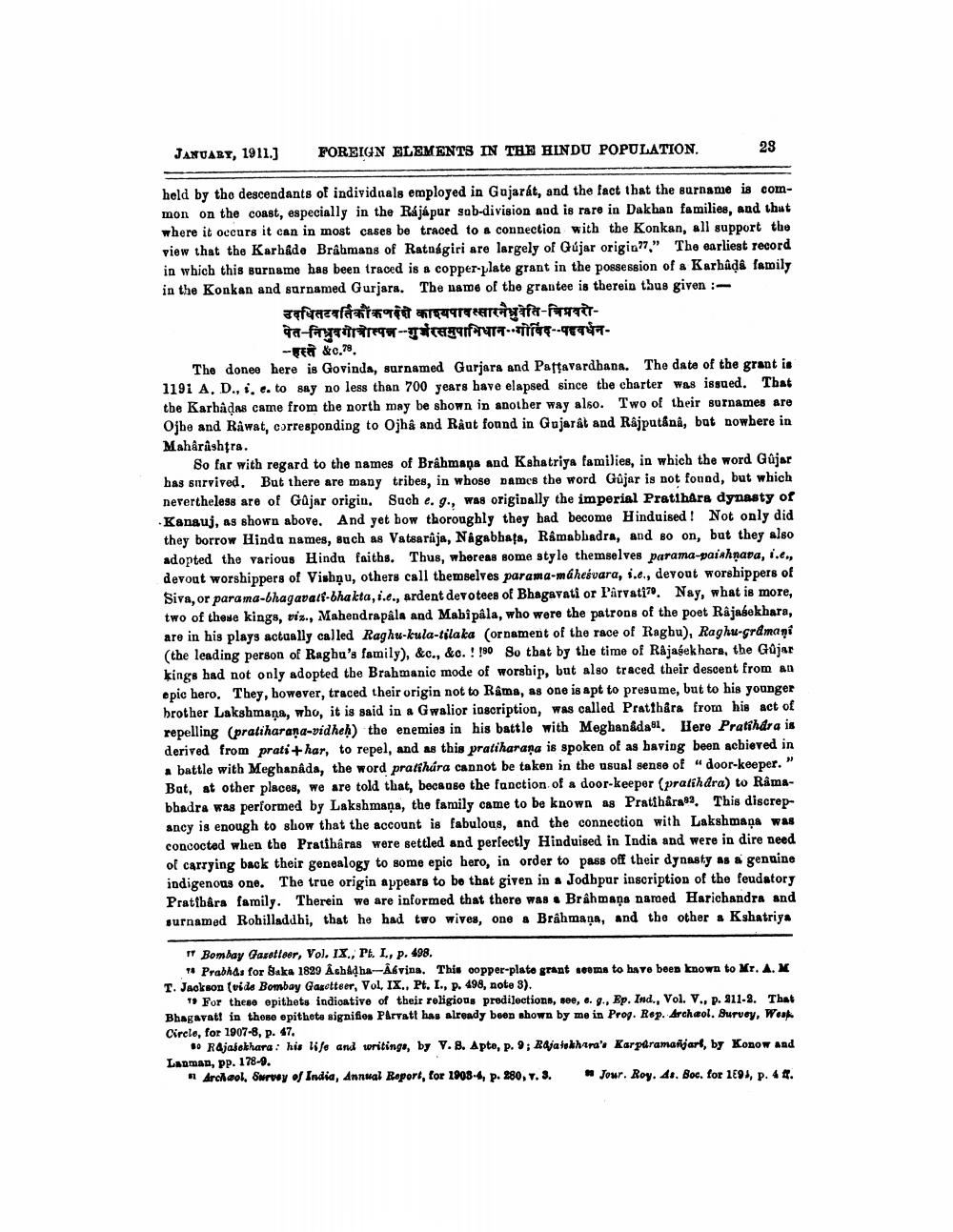________________
JANUARY, 1911.)
FOREIGN ELEMENTS IN THE HINDU POPULATION.
28
held by the descendants of individuals employed in Gujarat, and the fact that the surname is common on the coast, especially in the Rájápur sub-division and is rare in Dakhan families, and that where it occurs it can in most cases be traced to a connection with the Konkan, all support the view that the Karbade Brahmans of Ratnagiri are largely of Gújar origin77." The earliest record in which this surname has been traced is a copper plate grant in the possession of a Karhûda family in the Konkan and surnamed Gurjara. The name of the grantee is therein thus given :
उदधितटवर्तिकौंकणदेशे काश्यपावस्सारनैध्रुवेति-त्रिप्रवरोta-fyrir rew- an - r--4E969
-GEO &c.78 The donee here is Govinda, surnamed Gurjara and Pattavardhana. The date of the grant is 1191 A, D., i, e. to say no less than 700 years have elapsed since the charter was issued. That the Karbâdas came from the north may be shown in another way also. Two of their surnames are Ojhe and Rawat, corresponding to Ojha and Raut fonnd in Gujarat and Rajputânâ, but nowhere in Maharashtra.
So far with regard to the names of Brahmans and Kshatriya families, in which the word Gújar has survived. But there are many tribes, in whose names the word Gújar is not found, but which nevertheless are of Gajar origin. Such e. 9., was originally the imperial Pratihara dynasty of Kanauj, as shown above. And yet bow thoroughly they had become Hinduised! Not only did they borrow Hinda names, such as Vatsarâja, Nágabbata, Râmabbadra, and so on, but they also adopted the various Hinda faiths. Thus, whereas some style themselves parama-paishnava, i.e., devout worshippers of Vishņu, others call themselves parama-máheśvara, i.e., devout worshippers of Siva, or para ma-bhagavatt-bhakta, i.e., ardent devotees of Bhagavati or Parvati. Nay, what is more, two of these kings, vie., Mahendrapala and Mabipala, who were the patrons of the poet Rajasekhara, are in his plays actually called Raghu-kula-tilaka (ornament of the race of Raghu), Raghu-grdmani (the leading person of Raghu's family), &c., &c. ! 130 So that by the time of Rajasekhara, the Gûjar kings had not only adopted the Brahmanic mode of worsbip, but also traced their descent from an epic hero. They, however, traced their origin not to Rama, as one is apt to presume, but to his younger brother Lakshmaņa, who, it is said in a Gwalior inscription, was called Pratthara from his act of repelling (pratiharana-vidheh) the enemies in his battle with Meghanädal. Here Pratihdra is derived from prati + har, to repel, and as this pratiharaṇa is spoken of as baving been acbieved in
battle with Meghanada, the word pratfhára cannot be taken in the usual sense of “door-keeper." Bat, at other places, we are told that, because the fanction of a door-keeper (pratihdra) to Râmabhadra was performed by Lakshmana, the family came to be known as Pratihara. This discrepancy is enough to show that the account is fabulous, and the connection with Lakshmana was concocted when the Pratharas were settled and perfectly Hinduised in India and were in dire need of carrying back their genealogy to some epic hero, in order to pass off their dynasty as a genuine indigenous one. The true origin appears to be that given in a Jodhpur inscription of the feudatory Pratibâra family. Therein we are informed that there was • Brâhmaņa named Harichandra and surnamed Rohilladdhi, that he had two wives, one a Brahmaņa, and the other a Kshatriya
IT Bomlay Gasstleer, Vol. IX., PEL, P. 498.
** Prabhas for Baka 1829 Åsbadha-Ābvina. This oopper-plato grant soms to have been known to Mr. A. T. Jackson (vide Bombay Gasetteer, Vol. IX., Pt. I., P. 498, note 3).
" For these epithets indioative of their religious predilections, see, ... Ep. Ind., Vol. V., p. 211-8. That Bhagavatt in these opitheto signifies Parvatt has already been shown by me in Proy. Rep. Archaol. Survey, Work Circle, for 1907-8, p. 57.
50 Rajabokhara : his life and writings, by V.8. Apte, p. 9; Rajatokhara' Karparamarjart, by Konow and Lanman, PP. 178-9.
Archeol, Swrwey of India, Annual Report, for 1908-4, p. 280, v. 3. Jour. Roy. 41. Boc. for 1895, p. 44.




